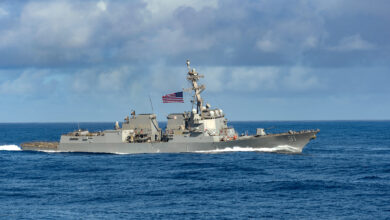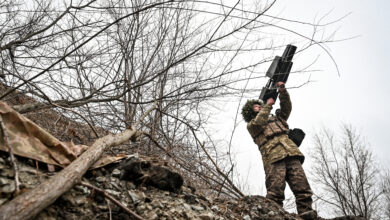
The US Navy needs to develop small missile boats that can be airlifted to places where larger ships and boats cannot sail to or will arrive too late.
Unlike the small special warfare boats that can be flown in to conduct low-end and low-intensity missions, this new generation of missile boats must be capable of high-end warfighting in a contested environment.
Small Enough for Airlifting
While Russia amassed the largest land force in Europe since World War II, the US Navy’s Carrier Strike Group and allied navies conducted exercises in the Mediterranean Sea, with no possibility of entering into the Black Sea to deter Russia’s invasion of Ukraine.
The geography and Turkey’s control over the Dardanelles and the Bosporus prevent the US Navy’s strike groups and large numbers of blue-water combatants from transiting into the Black Sea and operating within range of Ukraine.
Short of airlifting vessels into the Black Sea, the US Navy had no other realistic option to help save Ukraine.

However, the US Navy does not have missile boats capable of being airlifted by US Air Force Lockheed C-5 Galaxy and Boeing C-17 Globemaster III.
Such boats could operate where US cruisers and destroyers are too large to sail into and where existing US brown-water and Special Warfare (SPECWAR) craft are too lightly armed.
Although the US Navy acquired six Pegasus-class Patrol Hydrofoil Missile boats in the 1970s and 1980s to fight against Warsaw Pact missile boats in the Baltic Sea, the service never required a missile boat to be small enough for airlifting.
Mark V Special Operations Craft
The US Naval SPECWAR had the Mark V Special Operations Craft (MK V SOC), capable of being transported by the C-5 Galaxy. Larger than its successor, the Combatant Craft Assault, the MK V SOC was designed for a crew of five to use speed and stealth to carry up to 16 SEALs in SPECWAR missions.
Within 48 hours of notification, two USAF C-5 Galaxy aircraft can transport an MK V detachment of two craft with all the supporting shore vehicles, equipment, and personnel to commence operations within 24 hours after arriving at a forward staging location.

Combining anti-ship missiles, even one as small as the 410-kilogram Naval Strike Missile (NSM), to a craft that matches the MK V’s weight, size, and low radar cross-section is within the realm of the possible.
The MK V is larger and heavier than a contemporary class of missile boats, the Dvora-class fast patrol boat. The MK V displaces over 57 tons, is 25 meters long, and 5.25 meters high and wide. The Dvora is smaller, displaces 45 tons fully loaded, is 21.5 meters long, 5.5 meters wide, and can carry two heavier 538-kilogram Taiwan Hsiung Feng I missiles or two 430-kilogram Israeli Gabriel Mk I anti-ship missiles.
Broad Use
The solution does not need to be an MK V with NSM exclusively and is not limited to the fighting in Ukraine and the Black Sea.
These boats can be airlifted to operate with NATO in the Baltic Sea if Russia’s invasion of Ukraine expands to the Baltic states or deployed from well-deck amphibious warships to support the US Marine Corps Expeditionary Advanced Base Operations mission in the Indo-Pacific.
Germany’s refusal to provide missile boats to Ukraine in the lead-up to Russia’s invasion demonstrates the need for a US-made missile boat for allied and coalition navies that require an affordable modern missile boat.
 Andy Cichon is a retired United States Naval Officer, who has served in various ships and staffs, including as Air Warfare Project Manager at the Royal Australian Navy’s Australian Maritime Warfare Centre, and in the Chief of Naval Operations’ staff for the US Navy’s international engagement with Australia, China, Taiwan, South Korea, and Vietnam.
Andy Cichon is a retired United States Naval Officer, who has served in various ships and staffs, including as Air Warfare Project Manager at the Royal Australian Navy’s Australian Maritime Warfare Centre, and in the Chief of Naval Operations’ staff for the US Navy’s international engagement with Australia, China, Taiwan, South Korea, and Vietnam.
He works for SAIC as a civilian war gamer at the US Navy’s Tactical Training Group Pacific.
His views are his own.
The views and opinions expressed here are those of the author and do not necessarily reflect the editorial position of The Defense Post.
The Defense Post aims to publish a wide range of high-quality opinion and analysis from a diverse array of people – do you want to send us yours? Click here to submit an op-ed.











